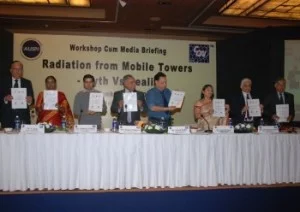 The first of its kind study, specific to the Indian environment carried out independently by the Premier Engineering Institutes revealed that “Levels of Radiation” from cellular/Mobile base stations BTS) in Delhi fall hundreds of times below international safety standards.
The first of its kind study, specific to the Indian environment carried out independently by the Premier Engineering Institutes revealed that “Levels of Radiation” from cellular/Mobile base stations BTS) in Delhi fall hundreds of times below international safety standards.
The independent study was commissioned by the Cellular Operators Association of India (COAI) and Association of Unified Telecom Service Providers of India (AUSPI) as a proactive measure stemming from the concern for the public health and safety issues.
Leading experts from the Indian Institute of Technology Madras, Chennai (IITM), Thiagarajar College of Engineering, Madurai (TCE) and Centre of Excellence in Wireless Technology, Chennai (CEWIT), while carrying out measurements on the electromagnetic radiation at over 180 locations in New Delhi found that in all circumstances, the “Cumulative Measurements” were well below the compliance limit set by the International Commission on Non-Ionizing Radiation Protection (ICNIRP), adopted by the Government for the Telecom sector in India, bringing it at par with the International safety standards.
While adopting international standards on public health and safety in 2008, companies in India must by law adhere to prescribed limits for Base Station Antennae for general public exposure.
The study measured cumulative emissions within the 800 to 2000MHZ band of frequency (which includes both GSM and CDMA technologies) across in the nation’s capital using carefully calibrated equipment, as per the Dot prescribed procedure in line with the ICNIRP specifications.. The basic restrictions/proper limits for power density specified in ICNIRP guidelines for safe frequencies between 400 to 2000 MHz are as follows:
| Type of Exposure | 900MHz(inW/m2) | 1800MHz (in W/m2) |
| Occupational | 22.5 | 45 |
| General Public | 4.5 | 9 |
Prof. P.R.Goundan, Joint Director Centre of Excellence in Wireless Technology, Chennai, stated that “It is one of the first studies carried out in the Indian environment to assess the level of emissions from the Mobile Towers. We are happy to note that the cumulative emissions are much below the prescribed limits and that the service providers in India are complying with the safety norms.
Prof. Dr.S.Raju, Head of Department ECE Thiagarajar College of Engineering, Madurai a leading scientist , awarded recently by the Tamilnadu State Government further stated that “ Any hazard to the public health is a larger societal concern. It is important that statements concerning public and health & safety should be well supported with facts and scientific evidence. The study brings out very clearly that even in the worst case scenario the cumulative emission levels were far below the INCNIRP standards.”
The study was commissioned in tandem by COAI and AUSPI, whose related aims include sustaining a world-class cellular infrastructure in India, the new finding come as a response to growing public concern over myths associated with the emissions from the cellular mobile towers and its alleged health effects on the human body.















